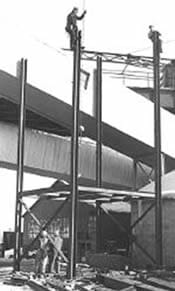
Summary
Students are introduced to some basic civil engineering concepts in an exciting and interactive manner via two lessons and three activities. Bridges and skyscrapers—the two most visible structures designed by civil engineers—are discussed in depth, including the design principles behind them. To help students visualize in three dimensions, one hands-on activity presents three-dimensional coordinate systems and gives students practice finding and describing points in space. After learning about skyscrapers, tower design principles and how materials absorb different types of forces, students compete to build their own newspaper towers to meet specific design criteria. The unit concludes with student groups using balsa wood and glue to design and build tower structures to withstand vertical and lateral forces.Engineering Connection
The ability to visualize in three dimensions is imperative to civil engineers. Engineers use a coordinate system whenever they create engineering drawings of structures, usually the Cartesian coordinate system. To build the tallest structures in the world, engineers must understand the importance of adequate foundations and redundancy in design to ensure safety and stability. To meet the challenge, engineers have devised and implemented many other creative designs and material uses so that their structures are able to withstand great forces. Students get a taste of these concepts and then apply what they have learned to create towers to meet specific objectives, as if they were civil engineers.
Unit Overview
Lesson 1, The Next Dimension: Students are introduced to the concept of 3-D coordinate systems and graphing, which are essential to civil engineering work. In an associated activity, A Place in Space, students practice finding points in space and describing the location of given points in space.
Lesson 2, Skyscrapers: Engineering Up!: Students are presented with a history of skyscrapers and their unnique structural engineering design principles. In an associated activity, Newspaper Towers, students compete to build newspaper towers of maximum height and ability to withstand wind forces. In a second associated activity, Balsa Towers, student groups use balsa wood and epoxy glue to build structurally sound towers with favorable strength-to-weight ratios.
Educational Standards
Each TeachEngineering lesson or activity is correlated to one or more K-12 science,
technology, engineering or math (STEM) educational standards.
All 100,000+ K-12 STEM standards covered in TeachEngineering are collected, maintained and packaged by the Achievement Standards Network (ASN),
a project of D2L (www.achievementstandards.org).
In the ASN, standards are hierarchically structured: first by source; e.g., by state; within source by type; e.g., science or mathematics;
within type by subtype, then by grade, etc.
Each TeachEngineering lesson or activity is correlated to one or more K-12 science, technology, engineering or math (STEM) educational standards.
All 100,000+ K-12 STEM standards covered in TeachEngineering are collected, maintained and packaged by the Achievement Standards Network (ASN), a project of D2L (www.achievementstandards.org).
In the ASN, standards are hierarchically structured: first by source; e.g., by state; within source by type; e.g., science or mathematics; within type by subtype, then by grade, etc.
See individual lessons and activities for standards alignment.
Subscribe
Get the inside scoop on all things TeachEngineering such as new site features, curriculum updates, video releases, and more by signing up for our newsletter!Unit Schedule
- Day 1: 3-D Coordinate System to Map Galaxies: The Next Dimension lesson
- Day 2: A Place in Space activity
- Day 3-4: Skyscrapers: Engineering Up! lesson
- Day 4-5: Newspaper Tower activity
- Day 5-7: Balsa Towers activity
More Curriculum Like This

Students learn about the history of the world's tallest free standing structures and the basic design principles behind their success. They build their own newspaper skyscrapers with limited materials and time, trying to achieve a maximum height and the ability to withstand a "hurricane wind" force...
Assessment
After this unit, students should be able to:
- Locate a point in space, given its coordinates and an origin.
- Use coordinates to describe the location of a given point in space relative to some origin.
- Explain why they built their towers the way they did, using the concepts and terms they learned in the history of skyscraper presentation.
- Explain how their towers resisted the wind load (for example, which tower parts supported the bulk of the load, or making the tower really slender so the wind has less area to act on, etc.).
Copyright
© 2013 by Regents of the University of Colorado; original © 2004 Duke UniversityContributors
Kelly Devereaux; Ben BurnhamSupporting Program
Techtronics Program, Pratt School of Engineering, Duke UniversityAcknowledgements
This content was developed by the MUSIC (Math Understanding through Science Integrated with Curriculum) Program in the Pratt School of Engineering at Duke University under National Science Foundation GK-12 grant no. DGE 0338262. However, these contents do not necessarily represent the policies of the NSF, and you should not assume endorsement by the federal government.
Last modified: February 15, 2018


User Comments & Tips